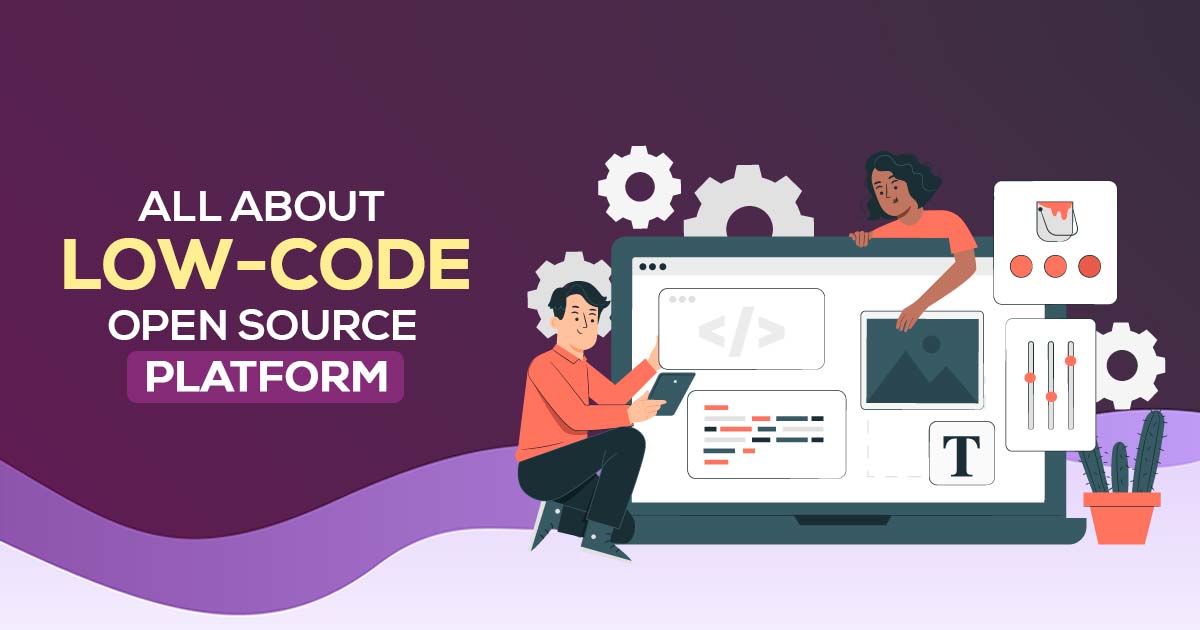
As technology advances at a rapid pace, it is essential for businesses across various industries to establish innovation hubs within their organizations. This step empowers employees with the ability to quickly address internal issues, create software solutions, and optimize and automate workflows.
An Open Source Low Code Platform, often referred to as OSLCP, represents a groundbreaking approach to software development that marries the principles of open-source collaboration with the advantages of low-code tools. This groundbreaking concept enables both organizations and developers to construct intricate software applications with less manual coding, increased speed, and improved collaboration, all while preserving the transparency and flexibility inherent in open-source projects.
Open-source low-code platforms facilitate brainstorming without necessitating significant upfront investments of time and money. These platforms place the capability to develop necessary applications and enhance processes within the grasp of business teams and citizen developers, broadening the pool of available talent.
Research indicates that low-code platforms are gaining popularity and find applications in various industries. Low-code development democratizes application creation, allowing everyday users with limited coding knowledge to take part.
Low-code development platforms have surged in popularity recently due to their capacity to simplify the application development process. They offer user-friendly interfaces and pre-built components that enable developers with minimal coding experience to quickly design, prototype, and deploy applications. This expedites development, reduces costs, and enables organizations to swiftly adapt to changing business demands.
Conversely, open source embodies the spirit of community-driven collaboration and transparency. Open-source software is accessible, customizable, and shareable by anyone, fostering an environment of innovation and knowledge exchange. Combining low-code development with open-source principles creates a potent paradigm with numerous advantages.
If you’re curious about what makes an open-source, low-code platform effective or how to select the right one, or if you’re concerned about the potential drawbacks of low-code platforms, this article provides answers. We will explore and define the concept of “open-source low-code” and introduce some of today’s top choices
What is an Open Source Low Code Platform?
An open-source low-code development platform directs to an open-source solution that allows users to build and launch applications via a drag-and-drop, graphical interface, rather than the older coding method.
In the coming years, there will be a significant increase in the demand for new applications, driven by the rapid expansion of software into various aspects of our lives.
However, IT departments in most organizations face a dilemma with two choices: purchasing the best available software solution or creating a new one from the start.
Choosing to purchase software is advantageous when an ideal product exists, as utilizing pre-made software is generally more cost-effective than developing your own. This route allows for quick implementation, often within days. Nevertheless, the drawback is that you’re limited to the features and capabilities provided by the vendor. Despite their promises in a product roadmap, the future changes to the product and its pricing remain uncertain.
For situations where a highly specific or custom solution is required, the traditional approach has been to develop it in-house. However, this approach demands a substantial investment of time and skilled personnel, and the project requirements frequently evolve significantly throughout the development process.
Advantages of Open Source Low-Code Platforms
IT teams globally are embracing an improved solution known as low-code development platforms. These platforms eliminate the need for intricate manual coding by introducing visual tools that enable dragging and dropping elements. These platforms enable developers to work at an accelerated pace, construct applications with reduced errors, and even facilitate non-technical individuals (citizen developers) in creating their own applications, alongside numerous other advantages.
Furthermore, low code helps mitigate the issue of shadow IT, wherein users independently create, discover, and manage software without IT’s awareness or oversight. By expediting application development, low-code empowers IT teams to maintain better control over software usage within the company.
Related: Open Source & Low-code Powering Digitalization, Check How?
Recent reports from IT departments indicate that 34 percent of surveyed individuals are currently utilizing a low-code platform, while an additional 9 percent are prepared to adopt it. According to Forrester, 40 percent of IT leaders have observed noteworthy or substantial enhancements in how they address the demand for customized app development through the implementation of low-code approaches.
Difference B/W Low-Code and Open Source Low Code Platforms
Prior to the rise of low-code platforms, many IT departments frequently turned to open-source software. Open-source software is generally available for free download and installation on your own server. It might be developed by a company that doesn’t intend to market or sell it, or it could serve as a free trial for additional paid features. Open-source software provides programmers with a head start when creating customized applications.
Low-code platforms differ from open-source software because, while you still begin with a clean slate on a low-code platform (despite the availability of helpful templates), you construct applications visually. Even when utilizing open-source software, manual code adjustments line by line are still necessary. In a low-code environment, many of these modifications occur graphically through drag-and-drop tools.
Naturally, there’s also the concept of an open-source low-code platform.
An open-source low-code platform follows the same principles as other open-source tools. Some provide the foundational system as open source and offer additional paid add-ons later as needed. Others present a “forever free” community version, unsupported by the vendor, allowing for an ongoing free trial until you decide to implement it across your business. While open-source low-code platforms are relatively uncommon, they do exist and could potentially offer a viable solution.
Comparing of Open Source and Licensed Low-Code Platforms
Open-source low-code solutions offer numerous benefits, primarily their affordability in comparison to alternative choices. They allow for extensive customization, and many genuine open-source variants provide reasonably priced supplementary features.
Nevertheless, utilizing open-source low-code tools is best suited for experienced programmers. Adapting a low-code development platform demands significant effort, and not many developers are inclined to invest time in enhancing a platform they didn’t create just to expedite future app development. While these tools can be effective, they are only suitable in specific scenarios where there is access to skilled and committed developers.
Opting for licensed low-code software proves more logical since the fundamental goal of using low-code is to accelerate app creation. When too much time is consumed with tinkering on an open-source product, the overall value diminishes. Licensed solutions come with enhanced support and a more refined product. This not only rejuvenates your development team but also opens possibilities for non-professional developers to engage with the platform.
The drawback of licensed low-code platforms is primarily associated with costs and the varying pricing structures across platforms. Some charge per application developed, while others consider the number of developer accounts or usage metrics.
Ultimately, the decision between a licensed version and an open-source low-code platform is most sensible after careful consideration
Various Types of Open Source Low-Code Platforms
Before impatiently proceeding to download the first open-source low-code platform, it’s important to acknowledge the existence of diverse categories.
General-purpose low-code platforms possess the capability to craft a wide array of applications, albeit often proving more complex for non-IT developers to navigate.
Certain low-code platforms are tailored to the specific environment where the application will operate. For instance, some platforms exclusively target web-based applications, while others are designed for mobile applications.
Conversely, there are platforms such as SDMT that concentrate on specific use cases like streamlining workflows and automating processes.
It’s imperative to note that not all scenarios are covered by an open-source alternative. Prior to selecting an open-source low-code platform, it’s crucial to ascertain its suitability for your intended project and to grasp the inherent limitations of the open-source offering. Are there any features that are bounded? Are there limited seats? What paid features are available? And how soon might you require them?
Why Open Source Low-code Platforms Must Not Be Your Preference
Utilizing an open-source platform comes with its advantages, such as being cost-free, highly customizable, and benefiting from the collective effort to enhance the source code. However, there are also inherent limitations.
When faced with the decision of selecting a low-code platform for your business, you are presented with the choice between an open-source tool and a closed-source or proprietary alternative. Opting for the open-source route can present numerous challenges. Let’s delve into why open-source low-code platforms might not be the optimal choice for your business and why proprietary software is a more viable option.
Reasons to avoid open-source low-code platforms for your business:
Integration Difficulties
Integration complications can manifest in various ways with no-code platforms. Open-source low-code platforms rely on the integration of multiple third-party components to function optimally, resulting in intricate management challenges.
But the situation is reversed for open-source projects. The standardized protocols required to integrate with the business tools you presently use are lacking on many open-source platforms. The smooth integration of proprietary software with other software products is frequently considered while designing it.
Concern for Security
The primary concern surrounding open-source low-code platforms revolves around security vulnerabilities. These platforms feature openly accessible source codes that can be examined and altered by anyone, including malicious actors.
This exposure increases the risk of the intentional creation of viruses for compromising hardware, software, data theft, or fraudulent activities. Proprietary platforms, in contrast, tend to implement stricter protocols to safeguard the platform against such risks.
Low Usability
Numerous open-source platforms prioritize functionality over user-friendliness. Although they might perform as intended, they often lack user-friendly interfaces and lack incentives for enhancing user navigation.
Closed-source platforms, on the other hand, prioritize usability. The companies behind them incorporate user-friendly features and intuitive interfaces tailored to users of varying skill levels.
Limited Support
Having dependable support from the chosen platform is essential. This ensures assistance is available in case of issues. With an open-source platform, there is no designated entity responsible for support. Consequently, if problems arise, there isn’t a specific point of contact for help. While many open-source low-code products boast active developer communities that may provide support, this often doesn’t match the robustness of support available from a proprietary tool.
What are the options available besides open-source low-code platforms?
SDMT stands as an excellent illustration of a closed-source low-code platform. It presents numerous advantages over open-source counterparts across various aspects. As an alternative to open-source platforms, SDMT embodies security, flexibility, and user-friendliness. This proprietary software solution places a strong emphasis on providing a user-friendly experience. Notably, it furnishes round-the-clock support, aiding users in resolving issues and seamlessly navigating the platform.
Due to its non-open-source nature, only the vendor holds the authority to modify the code, introduce features, or perform upgrades. The platform incorporates top-tier security measures, including enterprise-level security protocols and state-of-the-art encryption, effectively safeguarding against hacking and cyber threats.
Unlike open-source platforms, closed-source solutions are designed with profit in mind. This encourages frequent updates and feature enhancements, aligning with industry standards, ensuring customer satisfaction, and fostering competitive viability within the realm of low-code solutions.
Benefits of Using a Low-code Platform that is Closed
Low-code development platforms streamline the process of creating fully functional enterprise applications without necessitating manual coding. While various options exist, encompassing both open-source and proprietary solutions for code-free app development, SDMT stands out as a superior choice for several reasons.
This proprietary no-code platform offers numerous advantages over both open-source and closed-source alternatives. Some of its notable features and benefits include:
Comprehensive Development Toolkit
Expedite the creation and deployment of enterprise-grade applications by employing a solution that simplifies and centralizes app development. SDMT provides a comprehensive toolkit to oversee the entire development lifecycle, eliminating the need to start from scratch with custom code. It streamlines app modification and new build releases, all within the same platform.
Unrestricted Building Capacity
Utilize SDMT to construct, test, and launch an unlimited number of applications tailored for diverse use cases. Businesses across various industries can harness SDMT for their distinctive development and business process management requirements.
Ease of Use
SDMT empowers users to craft functional apps effortlessly through an intuitive drag-and-drop editor. It facilitates the expansion of app functionality and enables seamless app updates and enhancements without grappling with complicated lines of code.
Robust Integrations
With SDMT, you can construct apps featuring widgets, advanced forms, and robust workflows. Moreover, the platform facilitates integrations with multiple platforms, further extending the core capabilities of your low-code application.
Insights and Analytics
Employ SDMT to develop practical applications and monitor their performance using robust reporting, data management features, and advanced data visualization and analytics tools.








